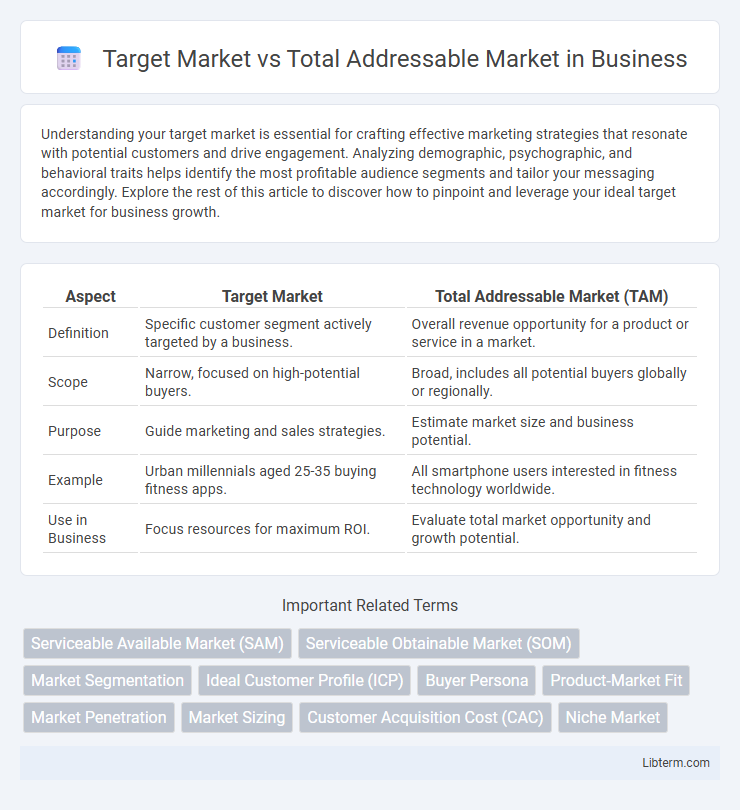Understanding your target market is essential for crafting effective marketing strategies that resonate with potential customers and drive engagement. Analyzing demographic, psychographic, and behavioral traits helps identify the most profitable audience segments and tailor your messaging accordingly. Explore the rest of this article to discover how to pinpoint and leverage your ideal target market for business growth.
Table of Comparison
| Aspect | Target Market | Total Addressable Market (TAM) |
|---|---|---|
| Definition | Specific customer segment actively targeted by a business. | Overall revenue opportunity for a product or service in a market. |
| Scope | Narrow, focused on high-potential buyers. | Broad, includes all potential buyers globally or regionally. |
| Purpose | Guide marketing and sales strategies. | Estimate market size and business potential. |
| Example | Urban millennials aged 25-35 buying fitness apps. | All smartphone users interested in fitness technology worldwide. |
| Use in Business | Focus resources for maximum ROI. | Evaluate total market opportunity and growth potential. |
Understanding Target Market vs Total Addressable Market
Understanding the target market involves identifying a specific group of consumers most likely to purchase a product or service, narrowed from the broader total addressable market (TAM) which represents the entire revenue opportunity available. The target market is defined using demographic, psychographic, and behavioral characteristics to tailor marketing strategies effectively, while TAM quantifies potential market size in terms of revenue or units. Companies prioritize the target market for resource allocation and strategic focus, using TAM as an upper limit to gauge overall market potential.
Definitions: Target Market and Total Addressable Market
The Target Market refers to the specific group of potential customers at which a company aims its products or services, defined by demographics, needs, and preferences. The Total Addressable Market (TAM) represents the overall revenue opportunity available if a product or service achieves 100% market share across all possible customers. Identifying the Target Market within the TAM helps businesses focus marketing efforts and develop strategies aligned with realistic sales goals.
Key Differences Between Target Market and TAM
The Target Market consists of specific groups of consumers a company aims to reach with its products or services, characterized by defined demographics, behaviors, and needs. Total Addressable Market (TAM) quantifies the entire revenue opportunity available if a product or service achieves 100% market penetration across all potential customers. Key differences lie in scope and focus: Target Market is a realistically reachable subset optimizing marketing and sales efforts, while TAM represents the maximum theoretical demand without considering market limitations.
Importance of Identifying Your Target Market
Identifying your target market narrows down the total addressable market to the most relevant customer segments, enabling more efficient allocation of marketing resources and higher conversion rates. Understanding specific demographics, behaviors, and needs within the target market improves product development and messaging precision. This focused approach enhances customer acquisition strategies and drives sustainable business growth by addressing the highest-value opportunities within the broader industry landscape.
Calculating Your Total Addressable Market
Calculating your Total Addressable Market (TAM) involves quantifying the entire revenue opportunity available if your product or service achieved 100% market share within a specific segment. Methods for TAM calculation include the top-down approach, which uses industry research and reports; the bottom-up approach, which aggregates potential sales based on pricing and customer numbers; and the value-theory approach, estimating market potential based on the economic value your offering creates. Accurate TAM estimation guides strategic planning, investor presentations, and prioritizes market segments for your focused target market efforts.
How Target Market Impacts Marketing Strategies
The target market defines the specific group of consumers a business aims to reach, directly shaping marketing strategies by tailoring messaging, product features, and promotional efforts to the needs and preferences of this segment. Understanding the target market enables more efficient allocation of marketing resources and increases conversion rates by focusing on high-potential customers within the broader total addressable market (TAM). This focused approach contrasts with the TAM, which represents the overall revenue opportunity without segmentation, making the target market essential for practical and effective campaign execution.
TAM: Assessing Business Growth Potential
Total Addressable Market (TAM) quantifies the complete revenue opportunity available if a product or service achieves 100% market share within a specific segment. Evaluating TAM helps businesses identify the full market potential and guides strategic decisions for scaling operations and securing investments. Understanding TAM ensures resource allocation targets maximum growth avenues beyond the current focused Target Market.
Common Mistakes When Defining Markets
Confusing Target Market with Total Addressable Market (TAM) often leads to overestimating business potential and misallocating resources. Many companies mistakenly define their target market as the entire TAM, ignoring the specific customer segments most likely to convert and generate sustainable revenue. Accurate market segmentation and understanding buyer personas prevent strategic errors and optimize marketing efforts.
Target Market Segmentation Best Practices
Target Market segmentation involves dividing the broader Total Addressable Market (TAM) into distinct groups based on demographics, psychographics, behavior, and geographic location to enhance marketing precision. Best practices include utilizing data analytics to identify high-value customer segments, aligning product offerings with specific needs, and continuously refining segments through customer feedback and market trends. Effective segmentation increases ROI by focusing resources on the most responsive and profitable subsets of the TAM.
Leveraging Market Data for Strategic Decisions
Leveraging market data for strategic decisions requires distinguishing the Target Market, which represents the specific group of customers a company aims to serve, from the Total Addressable Market (TAM), the entire revenue opportunity available for a product or service. Accurate analysis of TAM helps identify market potential and growth opportunities, while detailed Target Market insights enable tailored marketing efforts and resource allocation. Integrating data on customer demographics, purchasing behavior, and competitive landscape ensures precision in defining both markets, optimizing strategic planning and maximizing ROI.
Target Market Infographic

 libterm.com
libterm.com